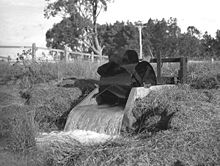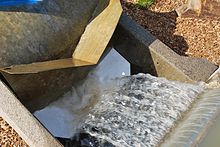- Dethridge wheel
-
An ornamental Dethridge wheel at Finley, New South Wales

The Dethridge wheel is used throughout Australia and in many other countries, including the United States, Israel and in Africa, to measure the flow of water delivered to farms for irrigation.
The wheel consists of a drum on an axle, with eight v-shaped vanes fixed to the outside. It sits laterally across a channel and is turned by water flow. The revolving wheel measures flow from the irrigation supply channels into the farm channels, providing the basis upon which irrigation farmers are charged for water. Wheels generally last for 15 to 20 years, and the axle is replaced every 5 years.[1]
The wheel was invented by John Dethridge in Australia in 1910. Dethridge was then commissioner of the Victorian State Rivers and Water Supply Commission.[2]
References
- ^ "99/97/1 Water meter, Dethridge wheel, steel, used by Murrumbidgee Irrigation Pty Ltd, Australia, 1990". Powerhouse Museum Collection 2.0. Powerhouse Museum. http://www.powerhousemuseum.com/collection/database/?irn=167968. Retrieved 2007-02-25.
- ^ Stein, Thomas M. "Dethridge meter (cumulative flow)". Sakia.org Irrigation Index. http://www.sakia.org/cms/index.php?id=289&type=5. Retrieved 2007-02-25.
- Green, KD (online 2000) [1988]. "Irrigation Development". Measuring farm supplies — the Dethridge wheel. Parkville, Victoria, AU: Australian Academy of Technological Sciences and Engineering. pp. page 157. ISBN 0-908029-49-7. http://www.austehc.unimelb.edu.au/tia/157.html. Retrieved 2007-02-21.

This tool article is a stub. You can help Wikipedia by expanding it.


